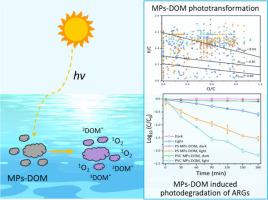当前位置:
X-MOL 学术
›
Water Res.
›
论文详情
Our official English website, www.x-mol.net, welcomes your
feedback! (Note: you will need to create a separate account there.)
Photochemistry of microplastics-derived dissolved organic matter: Reactive species generation and organic pollutant degradation
Water Research ( IF 11.4 ) Pub Date : 2024-11-17 , DOI: 10.1016/j.watres.2024.122802
Jie Zhang 1 , Xianfeng Hou 2 , Kena Zhang 1 , Quanzhi Xiao 1 , Jorge L Gardea-Torresdey 3 , Xiaoxia Zhou 2 , Bing Yan 1
Water Research ( IF 11.4 ) Pub Date : 2024-11-17 , DOI: 10.1016/j.watres.2024.122802
Jie Zhang 1 , Xianfeng Hou 2 , Kena Zhang 1 , Quanzhi Xiao 1 , Jorge L Gardea-Torresdey 3 , Xiaoxia Zhou 2 , Bing Yan 1
Affiliation

|
Dissolved organic matter (DOM) originating from microplastics (MPs-DOM) is increasingly recognized as a substantial component of aquatic DOM. The photochemistry of MPs-DOM, essential for understanding its environmental fate and impacts, remains largely unexplored. This study investigates the photochemical behaviors of MPs-DOM derived from two common plastics: polystyrene (PS) and polyvinyl chloride (PVC), which represent aromatic and aliphatic plastics, respectively. Spectral and high-resolution mass spectrometry analyses demonstrated that photoreactions preferentially targeted poly-aromatic compounds within the MPs-DOM, leading to degradation products that predominantly form N-aliphatic/lipid-like substances. This transformation is characterized by decreased aromaticity and unsaturation. Additionally, irradiation of MPs-DOM generated reactive species (RS), including triplet intermediates (3 DOM*) and singlet oxygen (1 O2 ), with apparent quantum yields of 0.06–0.16 % and 0.16–0.35 %, respectively—values considerably lower than those for conventional DOM (1.19–1.56 % for 3 DOM* and 1.34–1.90 % for 1 O2 ). Despite this, the RS generated from MPs-DOM significantly enhance the degradation of coexisting organic pollutants, such as antibiotic resistance genes (ARGs). The findings shed light on the photoinduced transformation of MPs-DOM and suggest that MPs-DOM functions as a natural photocatalyst, mediating redox reactions of pollutants in sunlit aquatic settings. This highlights its previously underestimated role in natural attenuation and aquatic photochemistry.
中文翻译:

微塑料衍生的溶解有机物的光化学:反应性物质的产生和有机污染物的降解
源自微塑料的溶解有机物 (DOM) (MPS-DOM) 越来越被认为是水生 DOM 的重要组成部分。MPS-DOM 的光化学对于了解其环境命运和影响至关重要,但在很大程度上仍未得到探索。本研究研究了源自两种常见塑料的 MPs-DOM 的光化学行为:聚苯乙烯 (PS) 和聚氯乙烯 (PVC),它们分别代表芳香族和脂肪族塑料。光谱和高分辨率质谱分析表明,光反应优先靶向 MPS-DOM 内的多芳香族化合物,导致主要形成 N-脂肪族/脂质类物质的降解产物。这种转变的特点是芳香性降低和不饱和度。此外,MPS-DOM 辐照会产生反应性物质 (RS),包括三重态中间体 (3DOM*) 和单重态氧 (1O2),表观量子产率分别为 0.06-0.16% 和 0.16-0.35%,远低于传统 DOM 的值(3DOM* 为 1.19-1.56%,1O2 为 1.34-1.90%)。尽管如此,MPS-DOM 产生的 RS 显着增强了共存有机污染物的降解,例如抗生素耐药基因 (ARG)。这些发现阐明了 MPs-DOM 的光诱导转化,并表明 MPs-DOM 起着天然光催化剂的作用,介导阳光充足的水生环境中污染物的氧化还原反应。这凸显了它以前被低估在自然衰减和水生光化学中的作用。
更新日期:2024-11-17
中文翻译:

微塑料衍生的溶解有机物的光化学:反应性物质的产生和有机污染物的降解
源自微塑料的溶解有机物 (DOM) (MPS-DOM) 越来越被认为是水生 DOM 的重要组成部分。MPS-DOM 的光化学对于了解其环境命运和影响至关重要,但在很大程度上仍未得到探索。本研究研究了源自两种常见塑料的 MPs-DOM 的光化学行为:聚苯乙烯 (PS) 和聚氯乙烯 (PVC),它们分别代表芳香族和脂肪族塑料。光谱和高分辨率质谱分析表明,光反应优先靶向 MPS-DOM 内的多芳香族化合物,导致主要形成 N-脂肪族/脂质类物质的降解产物。这种转变的特点是芳香性降低和不饱和度。此外,MPS-DOM 辐照会产生反应性物质 (RS),包括三重态中间体 (3DOM*) 和单重态氧 (1O2),表观量子产率分别为 0.06-0.16% 和 0.16-0.35%,远低于传统 DOM 的值(3DOM* 为 1.19-1.56%,1O2 为 1.34-1.90%)。尽管如此,MPS-DOM 产生的 RS 显着增强了共存有机污染物的降解,例如抗生素耐药基因 (ARG)。这些发现阐明了 MPs-DOM 的光诱导转化,并表明 MPs-DOM 起着天然光催化剂的作用,介导阳光充足的水生环境中污染物的氧化还原反应。这凸显了它以前被低估在自然衰减和水生光化学中的作用。





































 京公网安备 11010802027423号
京公网安备 11010802027423号